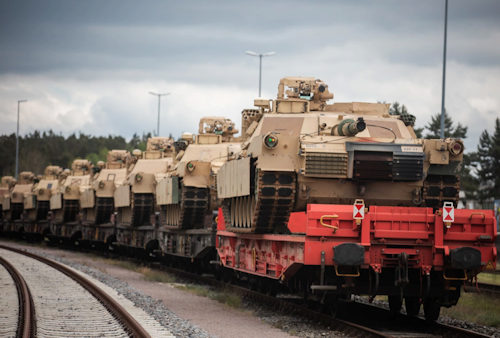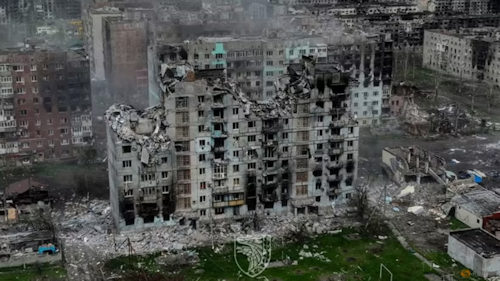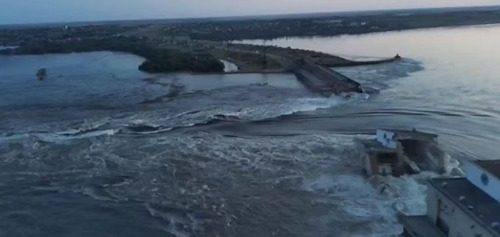The two main positive news for the Ukrainians in recent months have been the inability of the Russians to conquer the entire south of the nation and the arrival on the battlefields among their ranks of Western tanks. These should be about 120 of the so-called second generation and a half: about thirty Challenger-2 British and about ninety Leopard-2 from Germany, Canada, Poland, Portugal, Spain, Sweden and Norway. The number of tank at their disposal should therefore be a few hundred, including the older generation tanks, even if improved, like the T-72 e Leopard-1 (the latter probably arriving soon presumably after a substantial update especially on protection and engagement ability). Thirty more tanks Abrams-M1A1 US could arrive in August/September 2023.
With said weapon systems, the number of so-called large elementary units, the brigades, partially equipped (ie only at company level) with western tanks, could number a total of ten. Each brigade, made up of about fifteen maneuvering companies, will therefore be able to have one or two of these on tanks (about ten).
It goes without saying that the more modern armored component mentioned, if distributed to all the brigades, would be dangerously "diluted" being equal to only about a tenth of the entire combat capacity of the large elementary unit, but still capable of carrying out offensive actions of a certain relevance or to cover the typical employment guidelines of armored reserves. More conveniently, those tanks could also be organized at battalion level and in that case the Ukrainians could have 4 or 5 armored brigades and 4 or 5 mechanized brigades, the latter with a preponderance of BMP-type infantry and cavalry fighting equipment and Soviet-era BTRs (albeit modernized), marten Germans, Bradley, Humvee, M113 and MaxPro US, French AMX-10RC. Presumably from August-September, with the arrival of the Abrams-M1A1, a further two or three brigades could be formed with advanced heavy components. What the Ukrainians still lack is essentially more tanks and a sufficiently robust air component, both of which are essential for large-scale offensive actions.
The possible development of the Ukrainian counter-offensive
At the beginning of June 2023, the length of the front in Ukraine (including the area of the Dnepr River and excluding the border with Russia which, moreover, was also the scene of some Ukrainian incursions) was around 800 km in total. while the line of contact that could be affected by the main fighting is about 500 km.

Since May 2023, the Ukrainians have carried out preliminary actions which are still ongoing and which include, among other things: effective strategic communication (for example the continuous announcement of the counter-offensive which never arrived, however leaving the opponent in uncertainty), operations in depth (air forces, missiles and drones on paying targets such as ammunition and fuel depots, decision-making centers, power plants, concentrations of forces and logistic bases), demonstration and deception actions (such as the continuous raids on Belgorod to distract the adversary, in particular its forces in reserve and aircraft, sorties with drones into Russian territory) and the occupation with "riverine" amphibious actions of the islands on the left bank of the Dnepr River typical, so to speak, of specialized forces such as Regimental lagoons Serene of the Italian Army. It would have been precisely to avoid competing actions south of Kherson that the Russians would have blown up the Kakhova dam.
When still these preliminary actions (known by the Anglo-Saxon term "Shaping operations”, i.e. actions aimed at preparing the subsequent phases) are still in progress, the Ukrainians have begun to carry out, with essentially reconnaissance units, the so-called contact point to identify the strong and weak points of the opposing line-up. These reconnaissance forces are underway in these early June days. They have already produced some local successes near Orichiv south of Zaporizhzia, between Vremivka and Vuhledar just on the border between Zaporizhzhia and Donetsk regions, in Novodonetsk, on Bakhmut's flanks. Actions further north-east in Kupjansk and along the Svatova-Kreminna alignment cannot be ruled out.
It is necessary here to make a parenthesis on the bloody battle fought in recent months for Bakhmut, considered by many to be merely "symbolic", with no real operational value. It's not quite like that. It is true that the narration from both sides makes this type of battle an epic, thus making these localities rise to symbols of the valor of their soldiers. In fact, all this can contribute, in addition to the achievement of tactical and strategic objectives, to pumping pride, self-esteem, esprit de corps and fighting fury in the fighters.
The Russians had mercenaries from the Wagner security company act in that town for a long time, while in the rest of the line of contact, apart from Adviivka and Marinka near Donetsk and along the Svatova-Kreminna alignment, there has been months a stalemate and no decisive operations were conducted. It took seven months to conquer it almost entirely at the cost of tens of thousands of casualties between dead and wounded on both sides without apparently decisive results.

So why die for Bakhmut? Because it was one of the pivots that the Russians needed to be able to occupy what could in the future be one of the starting points for the attack of the Ukrainian counter-offensive, i.e. the Kramatorsk-Sloviansk area. However, despite having conquered the inhabited center of Bakhmut with the Wagnerites, the Russians have once again lost its suburbs to the north and south, making it almost useless again for their own purposes. So it could have been important but it's not anymore. Now it is much less fundamental for them but it is much more so for the Ukrainians who, starting from Kramatorsk-Sloviansk, are attacking it not frontally like the Russians but on the flanks (typical of Western doctrine) in order to then probably continue on to Donetsk or Luhansk.
What could happen in the coming weeks?
Once the weak points of the Russian deployment have been identified, the Ukrainians could proceed with the so-called Decisive Operationsi.e. decisive operations. It would be a question of breaking through the 1st group of Russians with the opening of breaches of a few kilometers in the enemy structure. There should be at least one major and one or two minor ones employing mechanized infantry, artillery and engineers as well as the newest players on the battlefield, drones. The impeding value of the passive and active obstacles built by the Russians will have to be verified: the more defensive lines have been built, the slower the progression of the Ukrainians will be, who could even get stuck on some alignment or be channeled into areas where the Russian armored reserves could surprise and annihilate them.
Penetration of a few kilometers along one or more lines would then be used to complete success by pushing forward into the main breach with the second line (generally armored forces, mainly tanks and infantry) to destroy the second line and the Russian reserves.
It is difficult to say what the final objectives could be, but hypotheses can be made. The most dangerous course of action for the Russians could be the Ukrainian occupation of Melitopol, Berdiansk or Mariupol. The loss of all or some of these cities on the Sea of Azov would mean that Moscow would no longer have the land corridor considered vital and painstakingly conquered at the beginning of the conflict to connect Russia to the Crimea. Two other important objectives could be the two capitals of the two phantom republics of Donetsk and Luhansk. Losing them would mean for the Russians to nullify the enormous military, social and economic efforts made in the last nine years to bring Donbass under their control.
 The partial destruction but with very serious consequences of the Kakhova dam, located on the Dnieper River in the Kherson region, also fits into this context. The causes of the collapse of the building are not yet clear. It could have been an explosion or the cumulative effect of previous fires. The fact is that 11 out of 28 spans are destroyed. These days we are witnessing the overflow of water through the destroyed area. The level of the reservoir upstream of the dam decreases at a rate of 15 cm. time.
The partial destruction but with very serious consequences of the Kakhova dam, located on the Dnieper River in the Kherson region, also fits into this context. The causes of the collapse of the building are not yet clear. It could have been an explosion or the cumulative effect of previous fires. The fact is that 11 out of 28 spans are destroyed. These days we are witnessing the overflow of water through the destroyed area. The level of the reservoir upstream of the dam decreases at a rate of 15 cm. time.
In addition, up to 300 houses in small towns in the area (Dnepryan and Korsunka) are flooded. In Novaya Kakhovka, the water reached the coastal road. 40 people were evacuated in the first hours after the flood while the environmental disaster promises to be extremely serious.
At the moment, however, there would be no danger for the Zaporizhzhia nuclear power plant: the structure provides for safety measures for the water supply in the event of such disasters.
Who benefits from the near destruction of the dam? The islands and the Russian-Ukrainian disputed area in the Dnieper Basin of Kherson Oblast are in the alluvial zone. The Ukrainian formations that had occupied them in recent weeks are now trying to evacuate the islands under Russian fire so as not to remain isolated by the water.
Systematic flooding is one of the methods of forbidding areas to an enemy about to attack. During the Cold War, we Italians also planned to flood some alluvial areas of the rivers in the north-east to slow down the progress of the Warsaw Pact tanks which, fortunately, we never had to counter. In the specific case of the dam, it is possible that the Russians did it to better defend themselves in view of the Ukrainian counter-offensive. By flooding the area in question, they have in fact achieved a number of goals: to dislodge the Ukrainian raiders who had settled on some islands on the left bank of the Dnieper River, to prevent the Ukrainians from exploiting the rolling stock located on the dam and to cover their left flank in view of the possible (and perhaps already underway) Ukrainian counter-offensive from the Zaporizhzia area towards the southern cities: Melitopol, Berdyansk and Mariupol.
How this will end is impossible to say at the moment. The number not very high of tanks of the latest generation and the lack of a sufficient number of ground attack and air defense aircraft, may force the Ukrainians to have to choose only one of the possible directions of attack. At that point a complete success, i.e. the liberation of all Russian-occupied areas, could only be achieved following a collapse, at the moment unlikely, of the entire Russian defense organization.
Moreover, as seen in the first counteroffensive of 2022, the Ukrainians have often favorably impressed us while the Russians have sometimes somewhat disappointed us. Anything can happen.
 * Retired army corps general of the Lagunari, former student of Nunziatella, former planner in the NATO Kosovo Force command, commander of the NATO national contingents in Kosovo in 2001 and the UN in Lebanon in 2006 and of the NATO multinational contingent based on the Garibaldi brigade in Afghanistan in 2012, currently a member of the Army Studies Center and author of the books “The Conflict in Ukraine” and “Dying for Bakhmut. The big war again in Europe”.
* Retired army corps general of the Lagunari, former student of Nunziatella, former planner in the NATO Kosovo Force command, commander of the NATO national contingents in Kosovo in 2001 and the UN in Lebanon in 2006 and of the NATO multinational contingent based on the Garibaldi brigade in Afghanistan in 2012, currently a member of the Army Studies Center and author of the books “The Conflict in Ukraine” and “Dying for Bakhmut. The big war again in Europe”.
Photo: web / US Army / Rai












